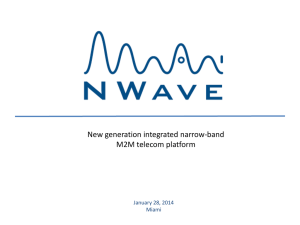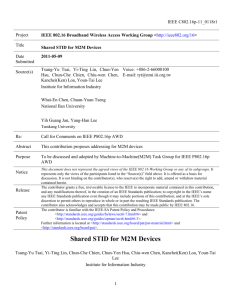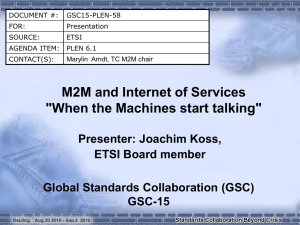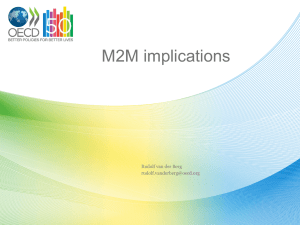C80216p-11_0028r2
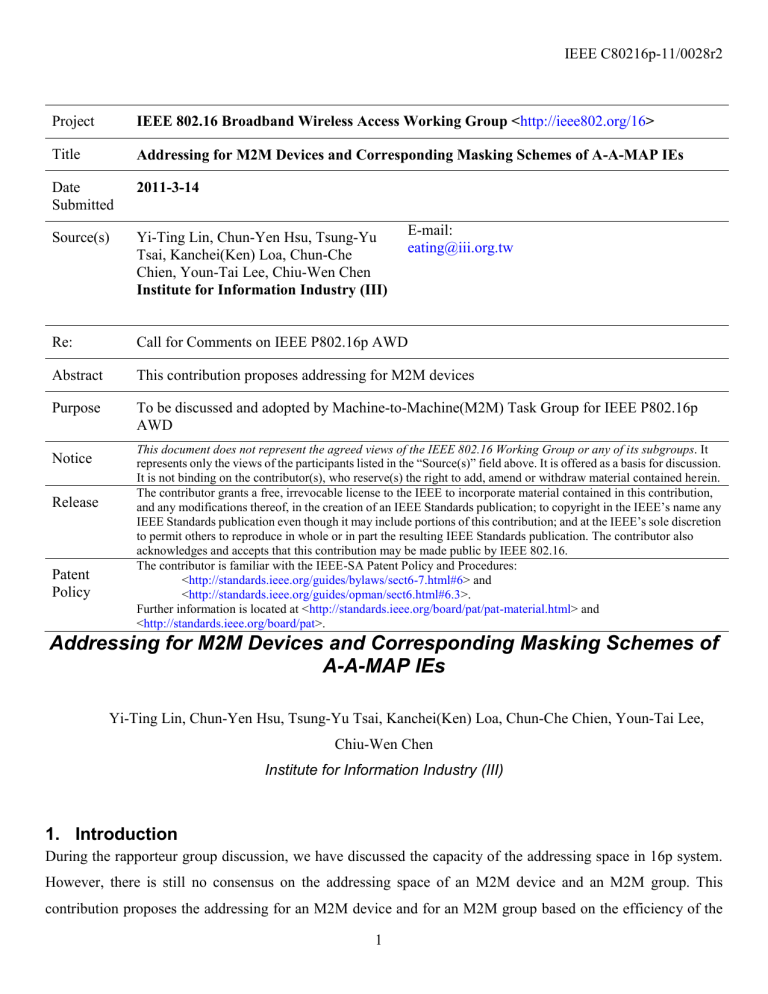
IEEE C80216p-11/0028r2
Project IEEE 802.16 Broadband Wireless Access Working Group < http://ieee802.org/16 >
Title Addressing for M2M Devices and Corresponding Masking Schemes of A-A-MAP IEs
Date
Submitted
2011-3-14
Source(s)
Re:
Yi-Ting Lin, Chun-Yen Hsu, Tsung-Yu
Tsai, Kanchei(Ken) Loa, Chun-Che
Chien, Youn-Tai Lee, Chiu-Wen Chen
Institute for Information Industry (III)
Call for Comments on IEEE P802.16p AWD
E-mail: eating@iii.org.tw
Abstract This contribution proposes addressing for M2M devices
Purpose To be discussed and adopted by Machine-to-Machine(M2M) Task Group for IEEE P802.16p
AWD
Notice
Release
Patent
Policy
This document does not represent the agreed views of the IEEE 802.16 Working Group or any of its subgroups . It represents only the views of the participants listed in the “Source(s)” field above. It is offered as a basis for discussion.
It is not binding on the contributor(s), who reserve(s) the right to add, amend or withdraw material contained herein.
The contributor grants a free, irrevocable license to the IEEE to incorporate material contained in this contribution, and any modifications thereof, in the creation of an IEEE Standards publication; to copyright in the IEEE’s name any
IEEE Standards publication even though it may include portions of this contribution; and at the IEEE’s sole discretion to permit others to reproduce in whole or in part the resulting IEEE Standards publication. The contributor also acknowledges and accepts that this contribution may be made public by IEEE 802.16.
The contributor is familiar with the IEEE-SA Patent Policy and Procedures:
< http://standards.ieee.org/guides/bylaws/sect6-7.html#6 > and
< http://standards.ieee.org/guides/opman/sect6.html#6.3
>.
Further information is located at < http://standards.ieee.org/board/pat/pat-material.html
> and
< http://standards.ieee.org/board/pat >.
Addressing for M2M Devices and Corresponding Masking Schemes of
A-A-MAP IEs
Yi-Ting Lin, Chun-Yen Hsu, Tsung-Yu Tsai, Kanchei(Ken) Loa, Chun-Che Chien, Youn-Tai Lee,
Chiu-Wen Chen
Institute for Information Industry (III)
1.
Introduction
During the rapporteur group discussion, we have discussed the capacity of the addressing space in 16p system.
However, there is still no consensus on the addressing space of an M2M device and an M2M group. This contribution proposes the addressing for an M2M device and for an M2M group based on the efficiency of the
1
IEEE C80216p-11/0028r2 masking schemes of the assignment A-MAP IEs. Grouping is an efficient scheme in transmitting multicast data to a group of devices instead unicasting a copy of data to each device individually. We propose to separate the addressing of an M2M device for unicasting transmission and the group addressing of an M2M group for multicasting transmission. Our consideration has following three:
1.
Each unicast A-MAP IE does not need adds overhead from the group addressing. The overhead is bad especially for transmission by large number of devices.
2.
If we should follow the identification scheme and resource block assignment of WirelessMAN-Advanced
Air Interface, which means that an M2M device ID and radio resource for an M2M device are assigned by the Base Station, there are no devices with the same M2M device ID in a cell. Therefore an M2M device ID can be solely used to identify a M2M device in a cell.
3.
For multicast transmission, grouping is efficiency in transmitting “a data” to all the devices within a group, and it is not necessary to identify each M2M device within a M2M group.
So we shall separately discuss the unicast transmission for an M2M device and the multicast transmission for an
M2M group. In suggested remedy 1, a masking scheme for both information and CRC is proposed to let M2M device exclusively identify the unicast Assignment A-MAP IEs with 16-bit M2M_ID. In suggested remedy 2, a masking scheme for an M2M group is proposed to let M2M group exclusively identify the Broadcast
Assignment A-MAP IE with 16-bit MGID.
Reference
[1] IEEE P802.16m/D12, “Part 16: Air Interface for Broadband Wireless Access Systems: Advanced Air
Interface,” Feb. 2011.
2.
Text proposal for inclusion in the 802.16p AWD
Suggested Remedy 1
[ Add the following text into the 802.16p AWD ]
------------------------------------------------------------------------- Text Start --------------------------------------------------------------------------
16.2.1.3.2 M2M Device Identifier (M2M_ID)
A 16-bit M2M_ID uniquely identifies an M2M device in the domain of the ABS supporting M2M service.
16.3.5.3.2.4 Assignment A-MAP
The Assignment A-MAP (A-A-MAP) shall include one or multiple A-A-MAP IEs and each A-A-MAP IE is encoded separately. Figure 540 describes the procedure for constructing A-A-MAP symbols for AMSs . Figure xxx describes the procedure for constructing A-A-MAP symbols for M2M devices.
2
IEEE C80216p-11/0028r2
Figure 540 – Chain of A-A-MAP IE to A-A-MAP symbols for AMSs.
A-A-MAP
IE Randomizatio n
4 bit MSBs of
16 bit STID masking
CRC addition
Channel encoding
QPSK modulator
MIMO encoder/ precoder
A-A-MAP
symbols
Figure xxx – Chain of A-A-MAP IE to A-A-MAP symbols for M2M devices
The 40 bits of information contained in the A-A-MAP IE are masked by a sequence generated by a PRBS generator. The mask, when XOR'ed with the A-A-MAP IE, randomizes the A-A-MAP IE. When a MAP-Mask
Seed is used to initialize the PRBS generator, the mask also conceals the contents of the A-A-MAP IE from unintended users. The PRBS generator and the randomization process are described in 16.3.10.1.3.
When the 16-bit CRC Mask Type Indicator is 0b000, the 15-bit initial vector of the PRBS generator shall be the value of the MAPMask Seed that was transmitted to the AMS in the same MAC control message as the STID or
TSTID value used as the 16-bit CRC Mask Masking Code. Otherwise, the 15-bit initial vector of the PRBS generator shall be the same as the 16-bit A-A-MAP CRC mask in Table 843, excluding the 1 bit masking prefix.
For M2M devices, the 35~38 MSB bits of the randomized 40 bit A-A-MAP IE is further masked by the 4-bit
MSBs of 16 bit STID, ranging from 0b0001 to 0b1111. A 16-bit CRC, for which CRC16-CCITT as defined in
ITU-T recommendation X.25 is used, is generated based on the randomized sequence of information bits of the assignment A-MAP IE. Denote the corresponding polynomial of the randomized assignment A-MAP IE as m ( x ), that of the 16-bit CRC as p ( x ), and that of the 16-bit CRC mask as q ( x ) which is generated according to
16.3.5.5.2.4. The 16-bit CRC mask is applied to the 16-bit CRC by bitwise XOR operation.
The masked CRC is then appended to the randomized sequence of information bits of the assignment A-MAP
IE, resulting in a bit sequence of m ( x )
x 16 + p ( x )
q ( x ). The resulting sequence of bits shall be encoded by the
TBCC described in 16.3.10.2.
16.3.5.5.2.4 Assignment A-MAP IE
Table 843.—Description of CRC Mask
Masking Prefix (1 bitMSB)
0b0 Type Indicator
Remaining 15 bit LSBs
Masking Code
0b1
0b000
0b001
0b010
12 bit STID for AMSs or 12 bit LSBs of 16 bit STID for
M2M devices or TSTID
Refer to Table 844
Refer to Table 845
15 bit RA-ID: The RA-ID is derived from the AMS' random access attributes
(i.e., superframe number (LSB 5bits), frame_index
(2 bits), preamble code index
3
IEEE C80216p-11/0028r2 for ranging or BR (6 bits) and opportunity index for ranging or BR (2 bits)) as defined below:
RA-ID = (LSB 5bits of superframe number | frame_index | preamble_code_index | opportunity_index)
------------------------------------------------------------------------ Text End ---------------------------------------------------------------------------
Suggested Remedy 2
[ Add the following text into the 802.16p AWD ]
------------------------------------------------------------------------- Text Start --------------------------------------------------------------------------
16.2.1 Addressing
16.2.1.3 Address for machine to machine application
16.2.1.3.1 M2M Group Identifier (MGID)
A TBD 15 -bit value that uniquely identifies an M2M group which one or more M2M devices belong to in the domain of the entire network. This ID shall be used to control a group of devices (e.g., group paging) or to transmit the multicast data to the M2M devices.
The 15 bit space is used to assign MGID to M2M devices. The CRC for MAP_IE is masked with this 15 bit MGID for M2M Devices.
The CRC mask for unicast MAP IE and multicast MAP IE for M2M devices and M2M Group is set as follows.
– M2M Device
• CRC mask = 0000 | 12-bit LSBs M2M_ID (4-bit MSBs M2M_ID is used to mask IE contents)
– M2M Group
• CRC mask = 0 | 15 bit MGID
• 4 bit MSBs is 0011~0111
16.3.5.3.2.4 Assignment A-MAP
When the 16-bit CRC Mask is generated with masking prefix 0b0 and 15 bit MGID, the 15-bit initial vector of the
PRBS generator shall be the value of the MAPMask Seed that was transmitted to the AMS in the same MAC control message as the 15 bit MGID value used for generating the 16 bit CRC mask . Otherwise, the 15-bit initial vector of the PRBS generator shall be the same as the 16-bit A-A-MAP CRC mask in Table 843, excluding the 1 bit masking prefix.
16.3.5.5.2.4 Assignment A-MAP IE
Table 843.—Description of CRC Mask
Masking Prefix (1 bit MSB) Remaining 15 bit LSBs
0b0 Type Indicator Masking Code
4
IEEE C80216p-11/0028r2
0b1
16.3.5.5.2.4.13 Broadcast Assignment A-MAP IE
0b000
0b001
0b010
0b011 – 0b111
12 bit STID or TSTID
Refer to Table 844
Refer to Table 845
12 LSBs of 15 bit MGID
15 bit RA-ID: The RA-ID is derived from the
AMS' random access attributes
(i.e., superframe number (LSB 5bits), frame_index
(2 bits), preamble code index for ranging or BR (6 bits) and opportunity index for ranging or BR (2 bits)) as defined below:
RA-ID = (LSB 5bits of superframe number | frame_index | preamble_code_index | opportunity_index)
Syntax
Table 860—Broadcast Assignment A-MAP IE
Size
(bit)
Description/Notes
Broadcast_Assignment_A-MAP_IE()
{
A-MAP IE Type
Function Index
4
2
Broadcast Assignment A-MAP IE
0b00: This IE carries broadcast assignment information
0b01: This IE carries handover ranging channel allocation information
0b10: This IE carries multicast assignment information
0b11: reserved This IE carries multicast assignment information for M2M application
…
}
} else if {Function Index == 0b11} {
Burst Size
Resource Index
Long_TTI_Indicator
Reserved
6
11
Burst size as indicated in the first 39 entries in Table 958
512 FFT size: 0 in first 2 MSB bits + 9 bits for resource index
1024 FFT size: 11 bits for resource index
2048 FFT size: 11 bits for resource index
Resource index includes location and allocation size.
1 Indicates number fo AAI subframes spanned by the allocated resource.
0b0: 1 AAI subframe (default TTI)
0b1: 4 DL AAI subframe for FDD or all DL AAI subframes for TDD (long TTI)
16 Reserved bits
5
IEEE C80216p-11/0028r2
------------------------------------------------------------------------ Text End ---------------------------------------------------------------------------
Appendix. Analysis of the Proposed A-MAP IE Masking Scheme of
Unicast Transmissions for M2M devices
In the contribution, the 35~38 MSB bits of the A-A-MAP IE which corresponds to the unicast transmission of M2M devices are masked by the 4-bit MSB of the 16-bit M2M ID which is ranged from 0b0001~0b1111. In the appendix, the analysis of the proposed masking scheme considering the ambiguity issues when decoding the
A-MAP IE for AMS and M2M devices is provided. Here the ambiguity means the situation that a specific
A-MAP IE is decodable (the CRC check is passed after de-masking) by more than one users (AMS or M2M devices) and cause users to accept the incorrect scheduling information which is not meant for it.
Briefly speaking, it can be verified that:
1.
There is no ambiguity problem for all the A-MAP IEs corresponding to the unicast transmissions for either
AMSs or M2M devices (The A-MAP IEs which use Masking prefix 0b0 and Type indicator 0b000 in the corresponding A-MAP IE).
6
IEEE C80216p-11/0028r2
2.
On the other hands, for the A-MAP IEs corresponding to the non-unicast transmissions for either AMSs or
M2M devices (with other Masking prefix and Type indicator in the corresponding A-MAP IE), there exists the possibility that an A-MAP IE which corresponding to the unicast transmission of M2M devices may be decodable by the devices with non-unicast transmissions (the CRC check is passed after de-masking its
Masking prefix, Type indicator, RA-ID, or Masking codes), and so does the converse cases. However, the ambiguity problem can also be eliminated by simply check the type field in the decoded A-MAP IE and drop it if the type field is not as expected. For example, if a device which expects to decode an A-MAP IE corresponding to multicast transmissions decodes an A-MAP IE corresponding to unicast transmissions, it could just regard it as invalid and simply drops the decoded A-MAP IE.
We divide the ambiguities into four categories and analyze them respectively.
1.
The ambiguity issues between M2M devices and M2M devices with unicast transmissions
The masking bitmap m for an A-MAP IE corresponding to the unicast transmissions for an M2M devices can be regarded as a 22-bit bitmap and have the following form: m = [4-bit MSB of M2M ID |0 0 0 0 0 0 | 12-bit LSB of M2M ID]
The necessary and sufficient condition that an A-MAP IE corresponding to the unicast transmissions for an M2M device with masking bit m_1 can also be decodable by another M2M device having unicast transmissions with masking bit m_2 is that the corresponding polynomial of the bitmap m_1
m_2 can be divided by the CRC16-CCITT polynomial g x
x
16 x
12 x
5
1 . Then based on the relationship of the M2M IDs of the two M2M devices, it can be further divided into two cases:
Case 1 (The 4-bit MSB of the M2M IDs of the two M2M devices are the same):
In this case, the bitmap m_1
m_2 has the following form
[0 0 0 0 0 0 0 0 0 0| a 12-bit bit stream which is not all zero]
The corresponding polynomial of m_1
m_2
is with degree less than or equal to 12 and is not all zero. Thus, it is impossible to be divided by g(x) which has degree 16. Thus, it is impossible for the ambiguity problem to occur.
Case 2 (The 4-bit MSB of the two M2M devices are not the same):
In this case, the bitmap m_1
m_2 has the following form
[4-bit bit stream which is not all zero | 0 0 | 0 0 0 0 | a 12-bit stream]
The first part of the bitmap is a 4-bit bit stream which is not all zero, that is, it ranges from
0b0001~0b1111. In fact, there are only 15 22-bit bitmap with the 6-bit MSB having the form
[4-bit bit stream which is not all zero | 0 0]
7
and can be divided by g(x). We list them as follows:
IEEE C80216p-11/0028r2
[ 0001 | 00 | 0100 | 000010000100 ]
[ 0010 | 00 | 1000 | 000100001000 ]
[ 0011 | 00 | 1100 | 000110001100 ]
[ 0100 | 00 | 0001 | 001000110001 ]
[ 0101 | 00 | 0101 | 001010110101 ]
[ 0110 | 00 | 1001 | 001100111001 ]
[ 0111 | 00 | 1101 | 001110111101 ]
[ 1000 | 00 | 0010 | 010001100010 ]
[ 1001 | 00 | 0110 | 010011100110 ]
[ 1010 | 00 | 1010 | 010101101010 ]
[ 1011 | 00 | 1110 | 010111101110 ]
[ 1100 | 00 | 0011 | 011001010011 ]
[ 1101 | 00 | 0111 | 011011010111 ]
[ 1110 | 00 | 1011 | 011101011011 ]
[ 1111 | 00 | 1111 | 011111011111 ]
It can be observed that there is no 22-bit bitmap from above with which the seventh to tenth MSB bits are all zero. Since the seventh to tenth MSB bits of m_1
m_2 are always all zero, it is sufficient to conclude that the corresponding polynomial of m_1
m_2
can never be divided by g(x)
. Thus, it is also impossible for the ambiguity problem to occur.
2.
The ambiguity issues between M2M devices and AMS with unicast transmissions
Denote the masking bitmap of an M2M device for an A-MAP IE for unicast transmissions as m_1 and that of an AMS as m_2 . m_2 has the following form: m_2 =[ 0 0 0 0 0 0 0 0 0 0 | 12-bit STID of the AMS ]
Also, the necessary and sufficient condition that an A-MAP IE of unicast transmissions for the
M2M device is decodable by the AMS (and vice versa) is that m_1
m_2 can be divided by g(x ). m_1
m_2 can be expressed by the following form m_1
m_2
= [ 4-bit bit stream which is not all zero | 0 0 0 0 0 0 | 12-bit bit stream ]
8
IEEE C80216p-11/0028r2
Similar to the analysis of above, it can also be concluded that m_1
m_2 can never be divided by g(x), and thus there is no ambiguity problem between M2M devices and AMSs with unicast transmission.
3.
The ambiguity issues between M2M devices and other devices with non-unicast transmissions
In this situation, for an A-MAP IE corresponding to unicast transmissions of an M2M device, it is possible that there exists devices with non-unicast transmissions which decode the A-MAP IE successfully ( Pass the CRC check after de-masking ). However, in such cases, the ambiguity can still be simply resolved by checking the type field of the decoded A-MAP IE. More specifically, if a M2M device with unicast transmission decodes an A-MAP with the type filed corresponding to non-unicast transmissions, or a device with non-unicast transmission decodes an A-MAP IE with type field corresponding to unicast transmissions, they regard the decoded A-MAP IE as invalid and simply drop it.
Thus, there is also no ambiguity problem occurring between M2M devices with unicast transmissions and other devices with non-unicast transmissions.
9




